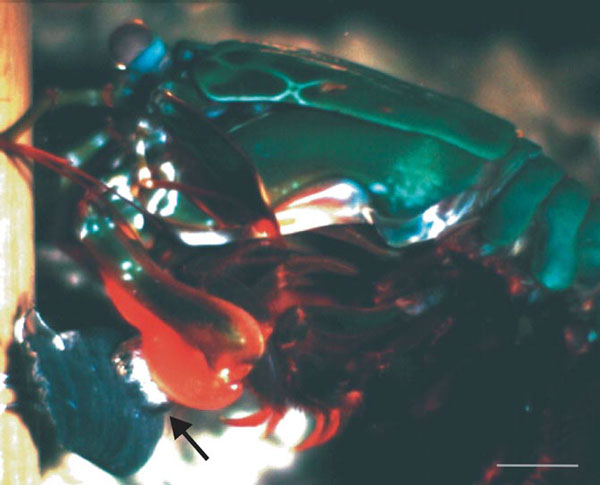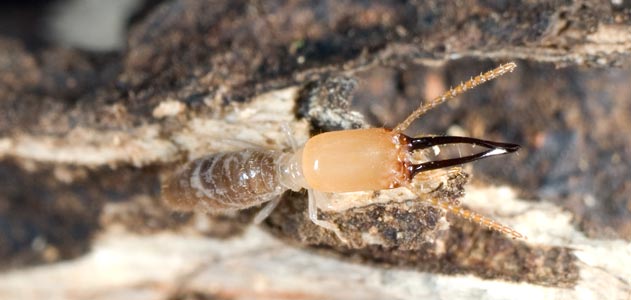It’s not easy to move fast. I say this not just out of laziness. The fact is, in the animal kingdom, moving quickly comes at a considerable energy expense. It also tends to wear down muscles and joints. So you can be pretty sure that whenever you see an animal that’s clocking in at a record speed, it’s doing so for a very, very good reason.
Take the case of the mantis shrimp. These incredible crustaceans come in two varieties: stabbers, and smashers. Sheila Patek is a biologist who studies them for a living. In a fascinating TED talk from 2004, she describes how mantis shrimp have the fastest blow in the animal kingdom. Their strike force is so great that it creates a visible shock wave in water, in a bizarre phenomenon known as cavitation. Patek goes on to describe the engineering solutions that these animals use to create and sustain their powerful smash.

Since 2004, the list of nature’s fastest has had more than a few additions. It’s the time of the year for holiday lists, so I decided to list some of the most impressive record holders in this regard. To do this, I relied mainly on references I found on the wonderful website of Patek’s lab.
The life forms that follow are pushing the limits of physics and engineering. Typically, they are doing this to rein death and terror onto hapless prey. They are the Terminator 2’s of our world. So please join me, as we descend down this list towards the most lethal of all blows. This is a quest for the fastest draw in nature.
But first, let’s start with something fast that we’re familiar with. When talking about short intervals of time, we often use the phrase ‘in the blink of an eyelid’. The time it actually takes us to blink an eyelid is about 3 tenths of a second or 300 milliseconds.
A blink of an eye (300 milliseconds)
So, our first point of reference is 10 milliseconds, or 1/30th of a blink of an eye
The ballistic tongue of the salamander (< 10 milliseconds)
The explosive tongue of the giant palm salamander of Central America bursts out in under 10 milliseconds, targeting flying bugs that don’t know what hit them. To achieve this feat, the tongue of this cold blooded sniper needs to output energy at the rate of a whopping 18,000 Watts per kilogram of muscle.
It stores this energy like a tightly coiled spring. As it relies on the principle of a slingshot, it can even operate in cold temperatures when muscles are slow to contract.
This tongue has been called the world’s most powerful muscle, but it’s no comparison to what follows.
The vacuum suction of the anglerfish (<5 milliseconds)
An anglerfish has what seems like a rather improbable fishing strategy.

It lures its prey in with a shiny dangling object attached to its head. All of a sudden, its mouth expands to more that 12 times its original size. The low pressure region thus created sucks in water at great speed, as well as whatever unfortunate fish happens to be swimming nearby. It’s a process that looks alarmingly like this.
And this strange kiss of death can take place in less than 5 milliseconds, or 1/60th of a blink of an eye.
The blinding strike of the mantis shrimp (2.7 milliseconds)
This has to be one of the most impressive punches in nature.
Sheila Patek and collaborators measured that the blow of the mantis shrimp can reach a peak speed of 51 mph (23 m/s), in less than 1/100 of the blink of an eye. All this while underwater! It’s so fast that it actually creates a visible shock wave. Meanwhile, its limb experiences over 10,000 g of acceleration.

To put this number in context, think of this: a typical person can handle an acceleration of about 5 g before losing consciousness, while decelerations of 100 g are about the highest that humans have survived, in Indy car racing accidents. A bullet shot out of a Beretta gun is accelerated by about 40,000 g.
If you were a snail or a clam, this could well be the last thing that you see:
Needless to say, a mollusk doesn’t stand much of a chance against this punch. The muscle that powers this impressive blow is delivering a mind-numbing 470,000 Watts per kilogram. It’s quite literally blowing the competition out of the water.
Well.. not quite. Read on.
The trapdoor stomach of the bladderwort plant (2 milliseconds)
The first plant to enter our list is, of course, carnivorous, and it has an insidious method of devouring its prey. Bladderworts are a genus of over 200 carnivorous plants, all of whom capture tiny animals with a bladder-like trap. I’ve been frightened of the bladderwort ever since I watched my favorite of all David Attenborough documentaries, the Private Life of Plants, that uses time lapse footage to demonstrate their chilling strategy.

Picture this. A plant with a tiny transparent capsule. The inner walls of the capsule pump water out, and in so doing create a partial vacuum inside. The outer walls of this capsule are lined with tiny, sensitive hairs. The trap is set.
If a mosquito larvae has the misfortune of brushing against these hairs, it triggers a trapdoor that opens in 2 thousandths of a second. The insect is sucked in with an acceleration of 600 g, so escape would literally be a miracle.
The swirl of water closes the trapdoor. One set of glands then secretes juices that digest the prey, while the other set sucks the water out. In just two hours, the trap is ready to be used once again and the prey has been dissolved.
Here is a video of scientists describing this process, with some bizarrely gratuitous sci-fi sounds thrown in at appropriate moments.
By now, we’ve moved down in time by an order of magnitude, to the level of 1 millisecond. Keep in mind, 1 millisecond is 1/300th of a blink of an eye
At this point, we reach the first (and only) life form in our list that isn’t using its speed to hunt.
The pollen cannon of the bunchberry dogwood (0.3 milliseconds)
At only 2 millimeters in size, you wouldn’t normally notice this tiny flower. But this inconspicuous flower is like a loaded gun, waiting for the right conditions to go off.
When triggered, its petals unfurl with incredible force, jettisoning its pollen out in a thousandth of the blink of an eye. In this time, the pollen is accelerated by about 2,400 g, and shoots up to an inch, or about 10 times the height of the flower.
Most flowers don’t rely on wind pollination, instead opting to use insects as the distributors of their pollen. The bunchberry dogwood prefers to diversify its strategy. If a large pollinator like a bumblebee were to land on it, the pollen cannon will fire, showering the bee. However, if a smaller, less-mobile insect such as an ant were to climb onto the flower, the flower will not waste it’s precious pollen. Ants are not heavy enough to trigger the cannon. And if no insects come by, it’s not a problem, as the wind can carry the pollen a meter away.
Not bad at all, for a tiny flower.
This is not the only plant to use explosive ejaculation. At this point, I should also mention the marvelous squirting cucumber. As this cucumber shaped fruit ripens, it fills with a liquid that builds up at an immense pressure. Eventually, the pressure reaches a point where the cucumber bursts open, and the seeds shoot out with speeds over 30 miles per hour. (See the Private Life of Plants for some slow-mo action.) The squirting cucumber deserves its own entry, but I couldn’t find a reference with accurate timing information, so this is what it gets.
We’re now at a tenth of a millisecond, or 1/3000th of a blink of an eye.
The multi-purpose ballistic jaw of the trap jaw ant (0.13 milliseconds)

If you’ve ever spent some time playing a first-person-shooter computer game, you’ll know that weapons can have multiple uses. Sure, you can use that rocket-propelled grenade to attack. But you can also use it for propulsion. A well placed shot to the ground can launch you high up into the air.
The trap jaw ant understands this. Its jaws are a lethal weapon, snapping shut with an explosive force that can equal 500 times the ants weight. In a tenth of a millisecond, the jaws reach a peak speed of 143 mph (64 m/s). A quick calculation puts the acceleration of this strike in at over 50,000 g. That’s the same acceleration that a bullet experiences as it leaves a gun!
With touch sensitive hairs that serve as a trigger, and an internal latch mechanism, they can control this formidable explosive force. But what is truly incredible is how they wield it. Not only does the ant use its trap jaw for attack, it can also use it for escape.
Scientists have documented two unconventional uses of its jaw, that go by the technical names of ‘bouncer defence’ and ‘escape jump’. The latter is pretty much what it sounds like. When the ant finds itself cornered in the ant equivalent of a dark alley, it can launch itself vertically 10 cm into the air and leap to safety. The other strategy, bouncer defence, would be familiar to anyone who, like me, has wasted their childhood playing violent video games. Essentially what you do here is strike the enemy, while using the recoil to propel yourself to a safe distance.
Really, this is all just an excuse to show you this Matrix style ant video:
I’m sure you’d agree that this is a pretty sophisticated ant.
Moving down the list, we have now reached a hundredth of a millisecond. We’re talking about a duration of time that happens 30,000 times in the blink of an eye. To put it another way, a hundredth of a millisecond is to a blink of an eye, what a blink of an eye is to two and a half hours.
Next on our list, we have:
The scissor-like jaws of the soldier termite (< 0.025 milliseconds)

The soldiers of the termite species termes panamaensis (Panama termites) are somewhat oddly shaped fellows. Their considerable, sword-like jaws and large, muscular heads take up more than half their bodies. The reason for this unwieldy headgear becomes abundantly clear when an unfriendly termite passes by. More than 70% of the time, this encounter results in death for the visitor (the number becomes 85% if you only consider visiting worker termites).
So how is this soldier termite butchering its foes with such ruthless efficiency? The key lies in speed. Its jaws snap open like a scissor, reaching a peak speed of 150 mph (67 m/s) in under 25 millionths of a second.
To power this absurd feat of strength, it relies on muscle that is delivering a peak power output of 11 Million Watts per kilogram. As far as I know, this is the most powerful muscle ever studied.
And now, we finally arrive at the end of the list, crossing a new threshold of speed. We have reached a thousandth of a millisecond, or a microsecond. This is to a blink of an eye, what a blink of an eye is to a day.
And the title of nature’s fastest draw (so far) goes to:
The retractable stingers of the jellyfish (0.0007 milliseconds, or 700 nanoseconds)
There’s fast, and then there’s mind-bogglingly, overwhelmingly, blazingly fast.

When a jellyfish detects its prey, it extends a kind of venomous vein. Like fiery filaments of doom, the job of these hair-like barbed structures is to inject neurotoxins into its prey. Here’s a video of this happening, shot under a microscope at 400x magnification.
Just how fast does a jellyfish arm itself? It turns out that the acceleration of these stingers as they emerge is 5,410,000 g. That’s not a typo.
Let me put it this way. The speed of light is a foot per nanosecond. So, in the time it takes for a jellyfish to whip out its stingers, light has travelled a distance of two football fields. It’s a timescale so fast, that the astronomical shifts down to the mundane.
And it is at this extreme scale where our journey ends, a scale where evolution is pushing up against the very laws of nature and against the speed limit of our universe. I’m excited (and a little afraid) to learn what we’ll discover next.
References:
In this article, I’ve focused on a specific way in which you can measure the fastest motion – the acceleration of an appendage relative to the body. There are, however, many other ways in which you might do this, each giving you a different champion. Here’s a splash of cold water from the lab of Dr. Patek:
Looking at peak sustained speeds – cheetahs might be the fastest. Or, focusing on peak unpowered speeds, diving falcons may be the fastest. On the other hand, if duration of the movement were the criterion of interest, nemtocysts and fungal spores would be the fastest. Lastly, considering acceleration of an appendage relative to the body through power amplification, then trap-jaw ants and termites come out on top.
Papers referenced:
Deban SM, O’Reilly JC, Dicke U, & van Leeuwen JL (2007). Extremely high-power tongue projection in plethodontid salamanders. The Journal of experimental biology, 210 (Pt 4), 655-67 PMID: 17267651
Grobecker DB, & Pietsch TW (1979). High-speed cinematographic evidence for ultrafast feeding in antennariid anglerfishes. Science (New York, N.Y.), 205 (4411), 1161-2 PMID: 17735055
Patek SN, Korff WL, & Caldwell RL (2004). Biomechanics: deadly strike mechanism of a mantis shrimp. Nature, 428 (6985), 819-20 PMID: 15103366
Vincent O, Weisskopf C, Poppinga S, Masselter T, Speck T, Joyeux M, Quilliet C, & Marmottant P (2011). Ultra-fast underwater suction traps. Proceedings. Biological sciences / The Royal Society, 278 (1720), 2909-14 PMID: 21325323
Edwards J, Whitaker D, Klionsky S, & Laskowski MJ (2005). Botany: a record-breaking pollen catapult. Nature, 435 (7039) PMID: 15889081
Patek SN, Baio JE, Fisher BL, & Suarez AV (2006). Multifunctionality and mechanical origins: ballistic jaw propulsion in trap-jaw ants. Proceedings of the National Academy of Sciences of the United States of America, 103 (34), 12787-92 PMID: 16924120
Seid MA, Scheffrahn RH, & Niven JE (2008). The rapid mandible strike of a termite soldier. Current biology : CB, 18 (22) PMID: 19036330
Nüchter T, Benoit M, Engel U, Ozbek S, & Holstein TW (2006). Nanosecond-scale kinetics of nematocyst discharge. Current biology : CB, 16 (9) PMID: 16682335